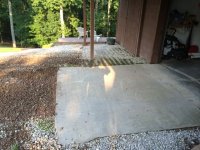Code54
Elite Member
- Joined
- Aug 20, 2005
- Messages
- 4,308
- Location
- Putnam Co. West Virginia
- Tractor
- Kubota MX5100, Kubota BX25D,1957 Farmall Cub Lo-Boy Kubota KX91-3, BCS 853
Im not a concrete guy but have a little project that I thought I would get some opinions on. The slab outside our garage has a break in it and I have another right inside the garage door. Today I started looking at it and pulled a piece out of the outside slab at the break and found there is some type of drain line running right where the concrete broke. It appears the pipe is only under about 1.5-2" of concrete so I know that is problem. Right now I am planning on tearing out the entire outside pad (total 9'x12'), taking up the part in the garage that is bad (maybe 18"'s of floor), redoing that line and making it deeper, then repairing everything. I am doing this on my own and don't really plan on asking anyone to come and help as all my friends are super busy on there own homes and I don't want to bother them. I did price ordering 2 yards of concrete and with delivery it is a hair more than using bagged mix. I also have a mixer I can use so that is not a problem and I like the idea of being able to work on this over several days/evening after work.
Now I just am not sure what size pad I can pour with bags (5'x10' maybe) and what is the best way to join the different pads? Also in the garage do I need to have a square cut line to join the new concrete to or can I drill into the rounded edge, put in rebar, and join it without cutting it square (I don't have a saw for concrete so that is why it is a bit of a pain)
I attached a few photos so it may help with the description of what I am doing. The reason I am doing it is because it looks bad, and water drains toward the garage. I plan on giving it a slight slope away from the garage to solve the problem in the future.


Now I just am not sure what size pad I can pour with bags (5'x10' maybe) and what is the best way to join the different pads? Also in the garage do I need to have a square cut line to join the new concrete to or can I drill into the rounded edge, put in rebar, and join it without cutting it square (I don't have a saw for concrete so that is why it is a bit of a pain)
I attached a few photos so it may help with the description of what I am doing. The reason I am doing it is because it looks bad, and water drains toward the garage. I plan on giving it a slight slope away from the garage to solve the problem in the future.

